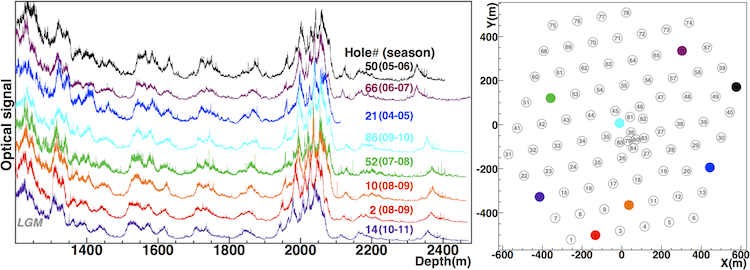From the most remote location on Earth, the IceCube Neutrino Observatory peers into deep space. The telescope uses thousands of light sensors built into a cubic kilometer of South Pole ice to reconstruct images of cosmic high-energy neutrinos. IceCube data must be corrected for tiny amounts of contamination, microscopic dust trapped within the ice of the telescope itself. These impurities originated here on Earth, as mineral dust lofted from continental landmasses and ash from ancient volcanic eruptions. First considered a nuisance, the dust in IceCube has become a subject for novel research, telling us vital stories about Earth’s past climate changes.
In a paper recently published in the Journal of Glaciology, the IceCube Collaboration presents a study of South Pole climate over the past 100,000 years, using high-resolution 3D laser images of the ice sheet. In order to better understand the response of the detector to the signals from neutrinos, IceCube deployed a borehole laser probe called the dust logger to depths of 2.5 km. An ice map from the probe was then applied to the telescope data to make precise corrections to the charting of cosmic neutrinos reaching IceCube. The undulating ice layers tilt by as much as 10% across IceCube, likely following the topography of the underlying bedrock almost two miles down.
By comparing the laser data to ice core measurements, the IceCube team was able to reconstruct an exquisitely detailed climate record of the last glacial period. A number of ash layers were identified around 74,000 years ago, near the age of the Toba super-eruption. Although from perhaps the largest volcanic event of the last two million years, Toba ash has never been found in polar ice. “IceCube is not only a unique astrophysics experiment, but also an extraordinary opportunity to study Earth’s past, to read the history preserved in South Pole ice,” explains Ryan Bay, an experimental physicist at UC Berkeley who led the study. The results have played a role in the designation of the South Pole as the site of the next major American ice coring mission.

Impurities that matter
The search for rare ultra-high-energy neutrinos coming from space requires a detector consisting of billions of tons of transparent material. And Antarctic ice is the cleanest, clearest natural solid on Earth. Every year, new snow falls at the South Pole trapping tiny samples of the atmosphere and its impurities. The snow accumulates and is eventually buried and converted to solid ice.
As the IceCube team bored into the ice, the hot-water drill was in effect traveling backward in time, melting through ice deposited many thousands of years ago. Reconstructing the record preserved in an ice sheet usually requires scientists to drill and retrieve an ice core, an intensive and arduous endeavor. The construction of IceCube allowed researchers to study the deep Antarctic ice sheet without having to obtain core samples.

Info “South Pole glacial climate reconstruction from multi-borehole laser particulate stratigraphy,” IceCube Collaboration: M.G. Aartsen et al. Journal of Glaciology 218 (2013) 59.